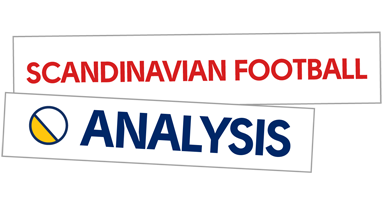For the last 13 seasons, Dag Eilev Fagermo has been synonymous with Odds Ballklubb. Therefore, going into the new season with former assistant Jan Frode Nornes taking charge naturally posed a few questions. Mainly, how Odd was going to play this season. Some readers might also remember them meeting Bundesliga side Borussia Dortmund in Europa League qualifiers in 2017, a two-legged fixture which ended 11-5 to the Germans.
He has kept the firm base Fagermo laid during his tenure. A compact and aggressive 1-4-5-1 without the ball, directness with the ball, high press to win the second ball, and a strong focus on set pieces. What Nornes has added to this base is a more patient approach in the build-up.
This tactical analysis in the form of a scout report will look at Odds Ballklubb in possession, and more specifically their build-up and goals from open play. It will explore the reasoning for their lack of goals from open play, the link to problems in the build-up, and at the end of this analysis, try to come up with possible solutions with examples from their tactics.
Goals from build-up
The trend is that teams higher in the table score a higher percentage of goals from open play, and vice versa for the bottom part. There are several reasons for this, and some will be explored further in later sections.
Last season in Europe’s big five leagues, teams scored on average 59.96% of their goals from open play. In Eliteserien the average for the league after 17 games played is 66.37%. Odds Ballklubb have scored 53.33% of their goals, 16 of 30, from open play. Only one club has a lower percentage (FK Haugesund), which is unusual for a team in third place. This is also similar to for example Juventus, who have gotten critique this season for not being good enough in attack.
Scoring a lot from set-pieces is inherently a good thing, as it is an extra weapon in a team’s arsenal. Being overly reliant on them to win games, as almost half of the total may suggest, is not.
When challenging for top spots, there is a need to be effective in possession. Odd currently have possession 55.3% on average this season, which is third in the league and presents the need for the effectiveness in possession.
That said, the priority is to look at the types of goals Odd do score. Below is an example of a typical move in the build-up which, in this case, leads to a goal.
Birk Risa, left-back and number five, passes the ball forward in the wing-space to Elbasan Rashani who turns home and plays a pass to the oncoming midfielder (bottom right). Rashani then keeps the width and starts a new run beyond the opponent’s back-line.
Risa continues his run towards the channel between the fullback and centre-back, taking the attention of the three closest opponents with him. Three seconds later, Rashani again receives the ball as can be seen in the image below. He brings the ball forward and plays it hard and low towards Mushaga Bakenga at the back post who places it easily into the net.
Counterattacks and counter-pressing
Another example of how Odd score a lot of their goals from open play is counter attacks. Primary trends in Odds style of play where they initiate counter-attacks are either winning the ball through pressing from their strict and compact medium block or counter-pressing on second balls.
The first picture below shows an example of Odd having pushed the opponent winger inwards where they have the numerical superiority. The opponent is then forced to play backward, a pass which in this case is too loose and the Odd striker can push aggressively forward to win the ball. He does so, and it results in a quick counterattack and goal.
The next image shows how Odd use the range of their goalkeeper to win second balls deep in the opponent’s half. Here, the goalie Sondre Rossbach has just kicked it long and an opponent centre-back won the first header.
The central midfielder is then trying to head the second ball back to his centre-back again, but this is where Odd swarm the receiver and wins the ball. They win the ball quickly and despite a few moments of chaos, it ends up with the Odd right-winger (in the black circle) who places it safely in the furthest corner from the edge of the box.
Loss of possession on the flanks
A natural part of football is losing the ball. However, where and how a team lose the ball differs greatly. As mentioned in the previous section, one of the common moves in the build-up for Odd is a pass from the fullback to the winger on the flank.
This is often a risky move as the winger usually has an opponent in his back and limited options. Mostly a lay-off to a central mid is the only option, if not the initial ball from the fullback is played into space for the winger to run onto.
This is, however, also a difficult move to pull off as the opponent fullback can push him against the sideline with cover from the centre-back. Below the image shows this specific move. Risa, the left-back, tries to bypass 3 lines of opponent pressure with one move. The move eventually ends up in a loss of possession while Odd have large distances in their possession structure.
The following example is focused on how they get the ball to the fullback who plays this pass. As the fullbacks starting position is close to the flank, he naturally is easier to press. This is because of the presence of the sideline.
In the following image, the centre back has just passed the ball and it is about to reach the fullback. There are two main problems here: The positioning of the fullback and the lack of progression from (or the initiation of) the pass. The positioning of the fullback in this situation makes it for the opposition winger to press. He can see both the centre-back and the fullback easily, and he can press forward.
When passing the ball, ideally the pass itself would either progress play or prepare the conditions for the following action to do so. This pass does neither as the pass itself is not anywhere close to a line of pressure. Also, because the fullback has very limited options. If he is not to pass it back, then his only options are dribbling or a long ball.
Lack of central options
This is the third and final example from build-up which will be explored from Odd in this tactical analysis. Here the left centre-back has progressed the ball until the first line of pressure. Centre-backs carrying the ball past lines of pressure can be very valuable.
It is often a good chance of doing it because most teams will have a free centre-back in the build-up. The problem in this situation is that of the central midfielders (the three furthest away marked yellow). Their body positioning shows that everyone is moving away. Also, the near-side fullback stays in his position instead of pushing up. Positioning behind the opposition winger as a fullback challenges the information gathering for the winger.
Ideally, the fullback would be positioned in line with the opposition winger or higher to make it harder to press. At least one central midfielder should present himself as an option.
An example here could be the middle one moving towards the six-space and showing for the ball, or the left one moving in between the winger and central midfielder of the opponent to receive behind.
Optionally, both could be done at the same time to present the opponent with trouble in their marking scheme. The move ends in a back pass to the fullback as marked with the striped line.
Beating the next line of pressure
In this section, the focus will be on the good situations Odd create in the build-up. When can they set up a teammate with good conditions for further play? They are showing promising signs and with time the percentage of goals from open play should rise. The first situation to look at is the image above where the right-back has the ball and have carried it forward and infield. This has engaged the opponent left-winger and opens up gaps in the opponent structure.
The first situation to look at is the image above where the right-back has the ball and have carried it forward and infield. This has engaged the opponent left-winger and opens up gaps in the opponent structure.
Further, the positioning of several players contributes to the move. The right central midfielder is positioned between the opponent central midfielders with enough space to turn and dribble towards the defensive line. The striker makes a move towards the goal, further increasing the space between the lines. The defensive midfielder of Odd is occupying the six-space, in case a lay-off may be necessary.
The pass ends up with the right central midfielder and they can bypass the first line of pressure.
This next situation shown in the image above provides a solution to the third example in the last section. The big difference between the two is that here the centre-back carrying the ball has a good option showing for the ball in central midfield. The ball reaches him, and he has enough time to turn.
Looking further ahead the right central midfielder is positioned well between the lines, creating a dilemma for the opponents. If he can get the ball, then he might use this to his advantage and drive the ball forward. This might produce a 2v1 versus the opponent fullback.
As one can see in the examples above, Odd is already doing a lot of things well. But in football, you are not good at something before you are doing it consistently. This might seem like very small details, but they are important nonetheless. What often separates a good team from a great team is executing the basics and the small details consistently good.
Conclusion
In this tactical analysis, I have explored how Odd score goals from open play. It is based largely around advancements on the flanks with crosses, counter-pressing on second balls, and counterattacks from a well-balanced and structured defence. In addition, I have looked at certain problems in build-up with potential solutions.
Odd sometimes make it hard for themselves with the choices and structure in possession. This is more frequent when they have the ball in their half, but there are also promising signs. Details on an individual but also team level will make the difference in the long run. It will be interesting to follow Odds Ballklubb for the rest of the season and see if Nornes can continue the development they have shown so far.














